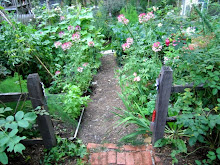As readers of this blog know, I am a big fan of heirloom and organic gardening and food production, but know that in practice (my backyard), the yields are much lower. Thus, heirloom and organic food is a luxury that many in this country cannot afford and in most countries is non-existent. In that context, I found this obituary interesting, particularly the difference in agricultural development in Asia, where famine has been eliminated, and Africa, where famine continues to persist.
.
From Gregg Easterbrook's obituary on Norman Borlaug in The Wall Street Journal. For the full article click here.
'As a young agronomist, Borlaug helped develop some of the principles of Green Revolution agriculture on which the world now relies including hybrid crops selectively bred for vigor, and "shuttle breeding," a technique for accelerating the movement of disease immunity between strains of crops. He also helped develop cereals that were insensitive to the number of hours of light in a day, and could therefore be grown in many climates.
.
Green Revolution techniques caused both reliable harvests, and spectacular output. From the Civil War through the Dust Bowl, the typical American farm produced about 24 bushels of corn per acre; by 2006, the figure was about 155 bushels per acre.
.
Hoping to spread high-yield agriculture to the world's poor, in 1943 Borlaug moved to rural Mexico to establish an agricultural research station, funded by the Rockefeller Foundation. Borlaug's little research station became the International Maize and Wheat Center, known by its Spanish abbreviation CIMMYT, that is now one of the globe's most important agricultural study facilities. At CIMMYT, Borlaug developed the high-yield, low-pesticide "dwarf" wheat upon which a substantial portion of the world's population now depends for sustenance.
.
In 1950, as Borlaug began his work in earnest, the world produced 692 million tons of grain for 2.2 billion people. By 1992, with Borlaug's concepts common, production was 1.9 billion tons of grain for 5.6 billion men and women: 2.8 times the food for 2.2 times the people. Global grain yields more than doubled during the period, from half a ton per acre to 1.1 tons; yields of rice and other foodstuffs improved similarly. Hunger declined in sync: From 1965 to 2005, global per capita food consumption rose to 2,798 calories daily from 2,063, with most of the increase in developing nations. In 2006, the United Nations Food and Agriculture Organization declared that malnutrition stands "at the lowest level in human history," despite the global population having trebled in a single century.
.
In the mid-1960s, India and Pakistan were exceptions to the trend toward more efficient food production; subsistence cultivation of rice remained the rule, and famine struck. In 1965, Borlaug arranged for a convoy of 35 trucks to carry high-yield seeds from CIMMYT to a Los Angeles dock for shipment to India and Pakistan. He and a coterie of Mexican assistants accompanied the seeds. They arrived to discover that war had broken out between the two nations. Sometimes working within sight of artillery flashes, Borlaug and his assistants sowed the Subcontinent's first crop of high-yield grain. Paul Ehrlich gained celebrity for his 1968 book "The Population Bomb," in which he claimed that global starvation was inevitable for the 1970s and it was "a fantasy" that India would "ever" feed itself. Instead, within three years of Borlaug's arrival, Pakistan was self-sufficient in wheat production; within six years, India was self-sufficient in the production of all cereals.
.
After his triumph in India and Pakistan and his Nobel Peace Prize, Borlaug turned to raising crop yields in other poor nations especially in Africa, the one place in the world where population is rising faster than farm production and the last outpost of subsistence agriculture. At that point, Borlaug became the target of critics who denounced him because Green Revolution farming requires some pesticide and lots of fertilizer. Trendy environmentalism was catching on, and affluent environmentalists began to say it was "inappropriate" for Africans to have tractors or use modern farming techniques. Borlaug told me a decade ago that most Western environmentalists "have never experienced the physical sensation of hunger. They do their lobbying from comfortable office suites in Washington or Brussels. If they lived just one month amid the misery of the developing world, as I have for 50 years, they'd be crying out for tractors and fertilizer and irrigation canals and be outraged that fashionable elitists in wealthy nations were trying to deny them these things."'
Welcome to Heirloom Gardener
Friday, September 18, 2009
"In 1999, the Atlantic Monthly estimated that Borlaug's efforts...saved the lives of one billion human beings."
Posted by
Julia Erickson
at
4:07 PM
![]()
![]()
Labels: Deep Thoughts About Gardening
Subscribe to:
Post Comments (Atom)
Search Heirloom Gardener
Labels
- About Blogging
- Annuals/Biennials and Perennials
- Autumn Garden
- Books and Movies
- Botanical Gardens
- Bulbs and Tubers
- Children's Garden
- Chrysanthemum
- Clematis
- Container Gardening
- Crocus tommasiniasus roseus
- Cut and Forced Flowers
- Cutting and Rose Gardens
- Dahlias
- Deep Thoughts About Gardening
- Egg Garden
- Fences Arbors Walls and Paths
- Floral arrangements
- Front Border
- Fun Stories About Gardening
- Garden Bloggers' Bloom Day
- Garden Bloggers' Design Workshop
- Garden Planning
- Gardening Blogs
- Gardening Tools and Structures
- Gardening with Children
- Goldberry Hill
- Heirloom and Organic Food
- Hibiscus
- Holidays
- Hydrangeas
- Japanese Beautyberry
- Lilies
- Mixed Borders
- New Jersey / Local Interest
- Nurseries
- Online Gardening Resources
- Peonies
- Pest Control
- Picture This Photo Contest
- Piet Oudolf
- Poppies
- Propagation and Seeds
- Pruning and Maintenance
- Roses
- Seed Heads
- Self Seeders
- Shrubs
- Spring Garden
- Summer Garden
- Trees
- Wildlife in the Garden
- Winter Garden
- Zinia
Blog Archive
-
▼
2009
(257)
-
▼
September
(28)
- Blotanical's Best Gardening Blogs for New Jersey 2009
- Bonica, Shrub Rose, on Goldberry Hill
- Frau Dagmar Hastrup (1914), Rugosa Rose, on Goldbe...
- Monarch Butterfly (Danaus plexippus) on the Butter...
- 2009 Blotanical Awards - voting ends in two days
- Dahlia in the Cutting Garden
- Purple Angelica Seed Heads
- Red Zinia in the Cutting Garden
- Dark Pink Zinia in the Cutting Garden
- Light Pink Zinia in the Cutting Garden
- White Zinia in the Cutting Garden
- Sweet Autumn Clematis in the Bird Garden
- "In 1999, the Atlantic Monthly estimated that Borl...
- Parsley Blooms in the Bird Garden
- Celebrate Fall at Reeves-Reed Arboretum in Summit,...
- Japanese Beautyberry - Flowers and Immature Berries
- Garden Bloggers' Bloom Day - September 2009
- Toad Lily, Tricyrtis formosana
- Picture This Photo Contest: Miscanthus sisnesis '...
- Milkweed Seeds in the Bird Garden
- Red and Yellow Milkweed in the Bird Garden
- Yellow Milkweed in the Bird Garden
- Herbaceous Hibiscus Buds in the Children's Garden
- Herbaceous Hibiscus Flower in the Children's Garden
- Shrub Hibiscus Flower in the Walled Garden
- Eastern Tiger Swallowtail Butterfly, Papilio glauc...
- Silver Spotted Skipper Butterfly, Epargyreus claru...
- Correction: Female Zabulon (not Hobomok) Skipper ...
-
▼
September
(28)























3 comments:
Thanks for an excellent post.
I read his obit in the NYT, so enjoyed your supplemental and link to the WSJ. Amazing man and fascinating story.
If I can write like you, then I would be very happy, but where is my luck like this, really people like you are an example for the world. You have written this comment with great beauty, I am really glad I thank you from my heart.
CAll Girls Huda Metro
Call Girls DLF Phase 1
Gurugram Call Girls Photos
Call Girls Suraj Kund
Escorts Service Phase 4
Busty Escorts Ardee City
Call Girls Noida
Call Girls Neemrana
Post a Comment